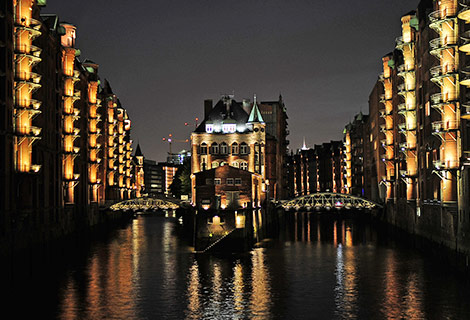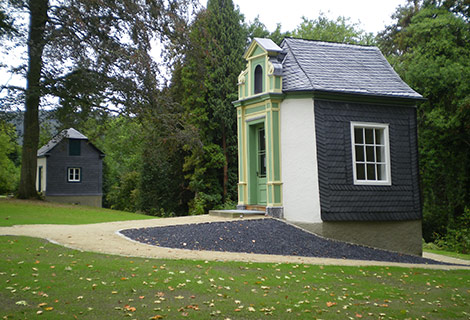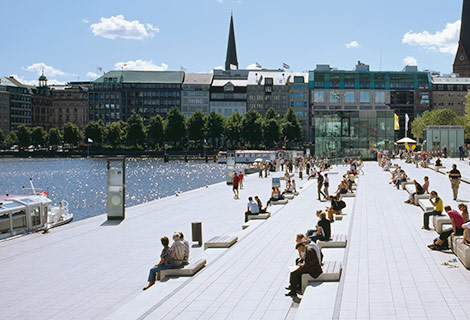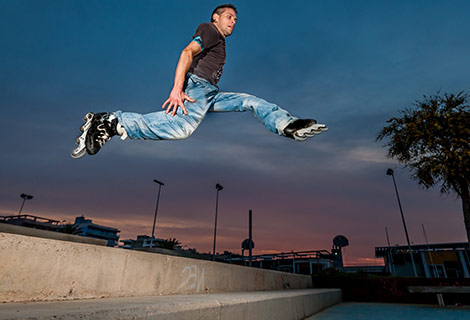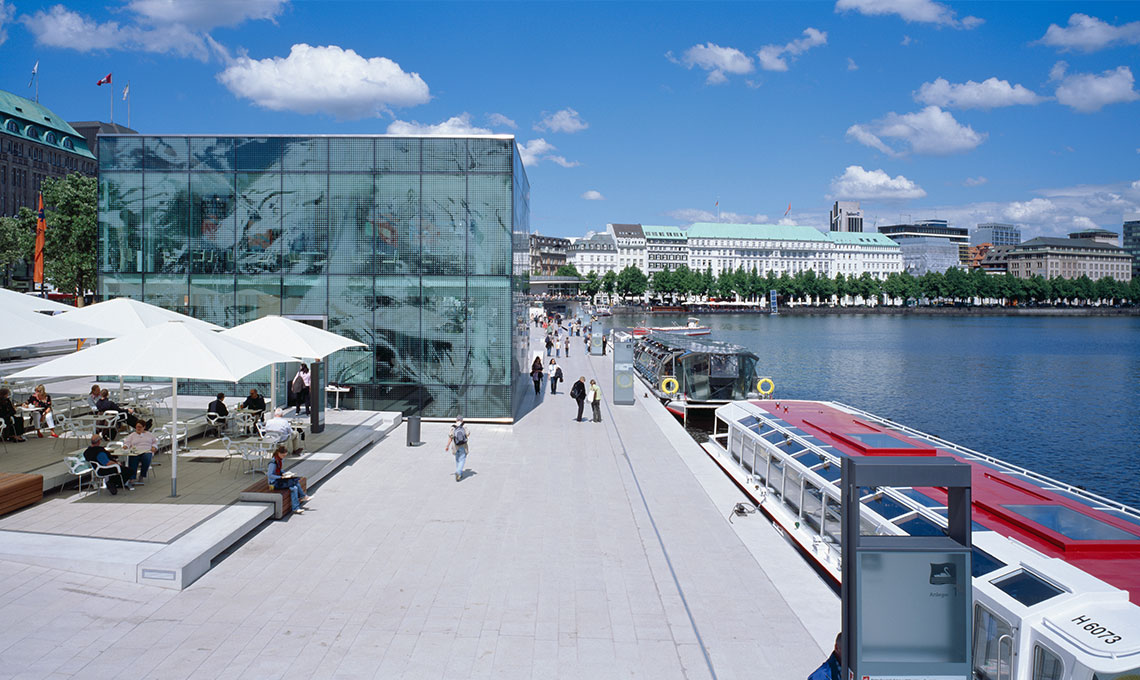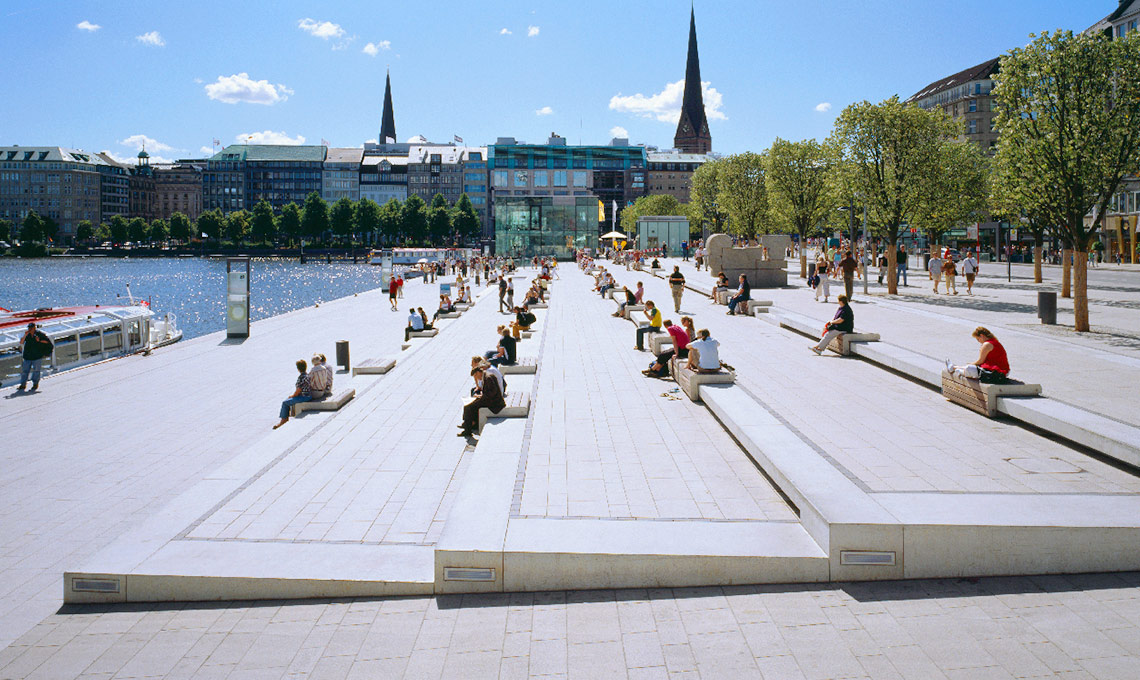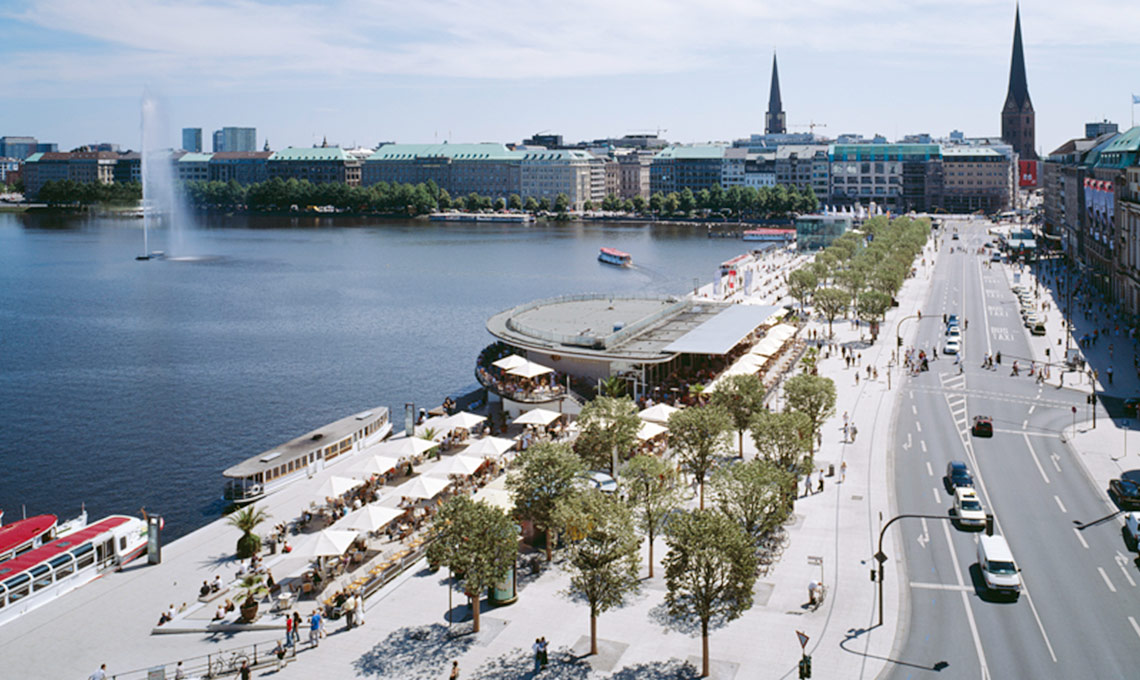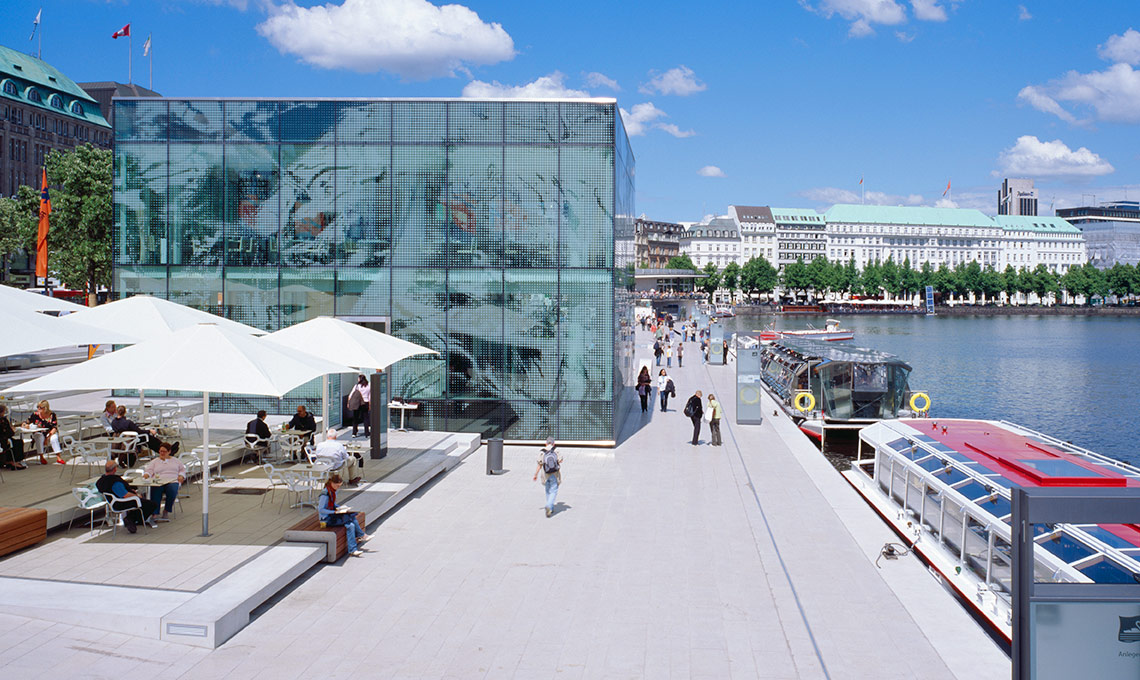Projects
Following an evaluation of its activities to date, the Foundation is committed to bringing a sharper focus to its support and promotion activities in public urban spaces. These activities can be assigned to the individual core themes of the Foundation – light, green or developed space - or simultaneously to more than one of these themes.
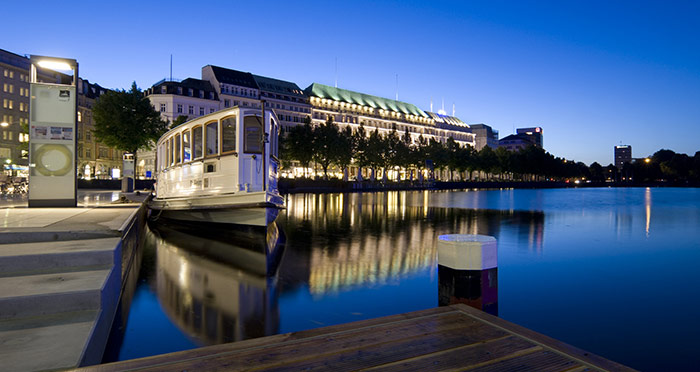
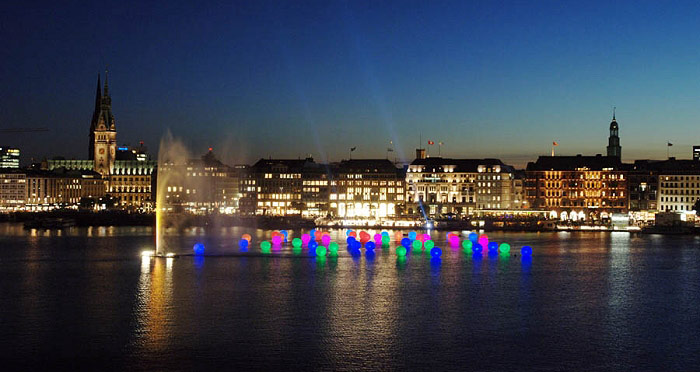
Jungfernstieg boulevard
New calling card at the heart of Hamburg city center
This is what the Jungfernstieg promenade looks like as of May 2006: a generously dimensioned system of steps across the full width of the Jungfernstieg and extending down to the water takes centre stage. In front of the steps, there is a boulevard with a three-wide lane of silver lindens planted in an alternating offset pattern.
The road area has been cleared, and there is an extended pedestrian zone in front of the facades. A new bus-stop allows passengers to disembark between the Gänsemarkt and Rathausmarkt squares. Further elements in the overall concept include a sophisticated illumination scheme with the emphasis on subtle, restrained lighting, a revised traffic routing system, improved access to the “Colonnaden”, and the demolition of the current pavilions (with the exception of the “Alsterpavillon”). The latter have been replaced by a transparent structure made of glass and translucent stone. Thanks to the tribune-like shape of the new pier with its moveable benches, the Alster also serves as a stage for events of all kinds. In addition, the Neuer Wall road has been connected to the pier.
Initiators of the project
The concept for the redevelopment of the Jungfernstieg was drawn up by a team comprising WES + Partner (landscape architects) and André Poitiers (architect). It was with this concept that the Hamburg-based team won the international competition “New Design for the Jungfernstieg”. Hamburg‘s Governing Lord Mayor Ole von Beust set up the international competition for ideas, which was funded by the “Lebendige Stadt” Foundation as well as a donation from Professor Dr. h.c. Werner Otto, in March 2002. Together with Chief Planning Director Prof. Jörn Walter, the architect Christoph Ingenhoven, and the Chairman of the Executive Committee of the Stiftung “Lebendige Stadt” Foundation, Dr. Andreas Mattner, Mayor von Beust presented the winning entries selected by an expert jury in Hamburg City Hall on July 12, 2002. The design concept was then revised and its viability confirmed by a feasibility study.
The then newly elected Mayor Ole von Beust, Chief Planning Director Jörn Walter, Professor Werner Otto and Dr. Andreas Mattner, Chairman of the Executive Committee of the "Lebendige Stadt" Foundation, held regular talks in 2002 on how to revitalize the Jungfernstieg promenade at the heart of Hamburg after the boulevard had become run down in previous decades, losing much of its splendor and vibrancy. After much discussion and debate, they finally came up with a solution.
Foundation of the association
A joint initiative of the “Lebendige Stadt” Foundation and the City of Hamburg led to the creation of the “Förderverein Lebendiger Jungfernstieg e.V.” (Friends of the Jungfernstieg) by prominent Hamburg citizens on July 22, 2002 – based on the realization that it would have been difficult to finance the redevelopment of the Jungfernstieg from public funds alone. The Association, chaired by former Mayor Mario Mettbach, Dr. Andreas Mattner, the Chairman of the Executive Committee of the "Lebendige Stadt" Foundation, and Dr. Stefan Schmittmann, Chairman of the Northern Region of Bayerische Hypo- und Vereinsbank AG, was the principal for the conversion work on the part of the project facing the river, coordinated the various aspects with neighboring owners and the local authorities, canvassed for private donations for the artistic, cultural and urban redevelopment of the Jungfernstieg and organized the opening ceremony from May 19-21, 2006. The city of Hamburg was responsible for the remaining elements in the plans, from road rerouting to refurbishment of the building facades.
In-depth consultation at the earliest possible stage with all the relevant decision-makers and the parties directly affected by redevelopment work played a key role in the implementation and success of this large-scale project. The bodies and companies represented through their membership of the "Lebendiger Jungfernstieg" Association included the Urban Development and Environment Agency, the Civic Cultural Affairs Department, the Senate Chancellery, the Monument Conservation Agency, the district authorities, the Chamber of Commerce, Hamburger Hochbahn AG, Alster-Touristik GmbH, Hamburg Tourismus GmbH, the City Management association, the local retailers and numerous other well-known Hamburg companies and local media. The make-up of the association ensured it was possible to discuss and take account of differing interests, problems and general fears throughout the planning process. All those involved in the planning process had the aim of promoting the good of Hamburg and the city's population and were therefore under a real obligation to commit themselves to this complex project and make their best efforts to ensure its success.
The donation pledge by Professor Dr. h.c. Werner Otto for a sum of five million euros signaled the symbolic green light for the start of redevelopment work. "Over the years, I have got to know many cities throughout the world, and it’s hard to think of any other city that currently has such a unique chance as well as the vitality to create a totally new location of such high quality in the city center. Having taken the necessary steps to finance the civic development competition, I now intend to go a step further by showing that visions of this kind can also be realized”, said Otto.
And this initiative proved a great success: more than 7.5 million euros in donations were collected for the 16 million euro project. Many entrepreneurs and private individuals like Otto's sons Alexander and Dr. Michael Otto, Dirk Möhrle, Professor Günter Fielmann, Lorenz von Ehren or Hellmut Wempe joined forces to support the project with donations and personal efforts and commitment, turning the Jungfernstieg into a shining example of successful public-private partnership. The redevelopment of the Jungfernstieg is a best practice model that serves as an example for other cities and communities.
Redevelopment of the Jungfernstieg
The first spade of earth was turned for the large-scale inner city project in September 2004 in the presence of Civic Development Senator Dr. Michael Freytag. The Alster quay has meanwhile been transformed into a spectacular "stairway installation" that resembles an open-air stage. A place that was virtually empty just a short time ago is now bustling with visitors who can once again enjoy the beautiful Alster panorama. In urban planning terms, the project has re-established the connection between the city and the water – and various cultural and artistic events on the area of the Jungfernstieg facing the water have made the promenade a vibrant cultural venue once again. The opening of the Jungfernstieg in May 2006 was accompanied by a big festival. Hamburg Governing Mayor Ole von Beust officially opened the redeveloped Jungfernstieg in the presence of Professor Werner Otto and his sons Alexander, Chairman of the Board of Trustees of the "Lebendige Stadt" Foundation, and Michael.
